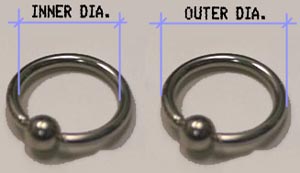Diabetes and Diameter: Difference between pages
(Difference between pages)
Jump to navigation
Jump to search
(Page conversion via llm-mediawiki-rev -jwm) |
(Page conversion via llm-mediawiki-rev -jwm) |
||
| Line 1: | Line 1: | ||
[[File:Diameter.jpg|right|300px|thumb|Diameter.jpg]] | |||
'''Body jewelry''' in a ring configuration is always measured by ''inner'' '''diameter'''. In smaller [[Gauge|gauges]], this doesn't make much difference, but when you consider a 2ga ring, the inner diameter may be 3/4", but because the [[Metal|metal]] itself is so thick, the outer diameter of the ring could possibly be over an inch and a quarter. | |||
It is important that ring diameter be chosen in a "piercing-appropriate" fashion - for example, a common mistake for inexperienced piercers is to use rings with too small a diameter for [[Nipple|nipple]] piercings (for example, 3/8" rings in a female nipple), failing to account for normal [[Swelling|swelling]] during [[Wound Healing|healing]], and erection/contraction related to temperature, leading to [[Rejection|rejection]]. | |||
== See Also == | |||
* [[Captive Bead Ring]] | |||
Latest revision as of 02:30, 17 September 2023
Body jewelry in a ring configuration is always measured by inner diameter. In smaller gauges, this doesn't make much difference, but when you consider a 2ga ring, the inner diameter may be 3/4", but because the metal itself is so thick, the outer diameter of the ring could possibly be over an inch and a quarter.
It is important that ring diameter be chosen in a "piercing-appropriate" fashion - for example, a common mistake for inexperienced piercers is to use rings with too small a diameter for nipple piercings (for example, 3/8" rings in a female nipple), failing to account for normal swelling during healing, and erection/contraction related to temperature, leading to rejection.
